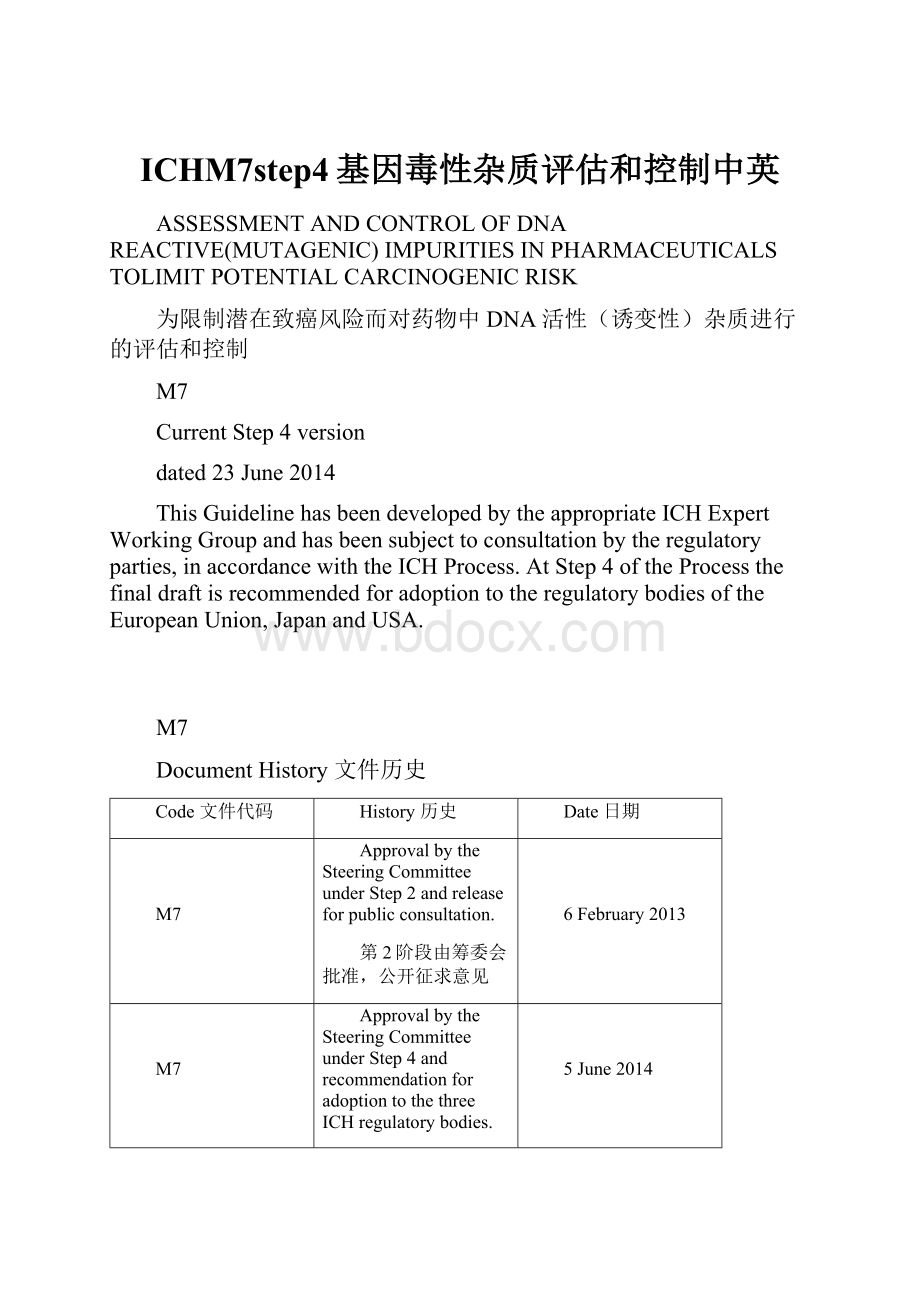ICHM7step4基因毒性杂质评估和控制中英.docx
《ICHM7step4基因毒性杂质评估和控制中英.docx》由会员分享,可在线阅读,更多相关《ICHM7step4基因毒性杂质评估和控制中英.docx(65页珍藏版)》请在冰豆网上搜索。

ICHM7step4基因毒性杂质评估和控制中英
ASSESSMENTAND CONTROLOF DNAREACTIVE(MUTAGENIC)IMPURITIESIN PHARMACEUTICALSTOLIMIT POTENTIAL CARCINOGENIC RISK
为限制潜在致癌风险而对药物中DNA活性(诱变性)杂质进行的评估和控制
M7
Current Step4 version
dated23June2014
ThisGuidelinehasbeendevelopedbytheappropriateICHExpertWorkingGroupandhasbeensubjecttoconsultationbytheregulatoryparties,inaccordancewiththeICHProcess.AtStep4oftheProcessthefinaldraftisrecommendedforadoptiontotheregulatorybodiesoftheEuropeanUnion,JapanandUSA.
M7
DocumentHistory 文件历史
Code 文件代码
History 历史
Date 日期
M7
ApprovalbytheSteeringCommitteeunderStep2andreleaseforpublicconsultation.
第2阶段由筹委会批准,公开征求意见
6February2013
M7
ApprovalbytheSteeringCommitteeunderStep4andrecommendationforadoptiontothethreeICHregulatorybodies.
第4阶段由筹委会批准,推荐ICH三方药监局采用
5June2014
CurrentStep4version 现行版本第4阶段
M7
Corrigendumtofixtypographicalerrorsandreplaceword“degradants”with“degradationproducts”throughoutthedocument.
修正输入错误,将全文中“degradants”替换成“degradationproducts”.
23June2014
LegalNotice:
Thisdocumentisprotectedbycopyrightandmaybeused,reproduced,incorporatedintootherworks,adapted,modified,translatedordistributedunderapubliclicenseprovidedthatICH'scopyrightinthedocumentisacknowledgedatalltimes.Incaseofanyadaption,modificationortranslationofthedocument,reasonablestepsmustbetakentoclearlylabel,demarcateorotherwiseidentifythatchangesweremadetoorbasedontheoriginaldocument.Anyimpressionthattheadaption,modificationortranslationoftheoriginaldocumentisendorsedorsponsoredbytheICHmustbeavoided.
Thedocumentisprovided"asis"withoutwarrantyofanykind.InnoeventshalltheICHortheauthorsoftheoriginaldocumentbeliableforanyclaim,damagesorotherliabilityarisingfromtheuseofthedocument.
Theabove-mentionedpermissionsdonotapplytocontentsuppliedbythirdparties.Therefore,fordocumentswherethecopyrightvestsinathirdparty,permissionforreproductionmustbeobtainedfromthiscopyrightholder.
ASSESSMENTAND CONTROLOF DNAREACTIVE (MUTAGENIC)IMPURITIESIN PHARMACEUTICALSTO LIMIT POTENTIALCARCINOGENIC RISK
为限制潜在致癌风险而对药物中DNA活性(诱变性)杂质进行的评估和控制
ICHHarmonisedTripartiteGuideline
ICH三方协调指南
Havingreached Step4 oftheICHProcessattheICHSteeringCommitteemeetingon5June2014,thisGuidelineisrecommendedforadoptiontothethreeregulatorypartiestoICH
TABLEOFCONTENTS
1.INTRODUCTION
概述
2.SCOPEOFGUIDELINE
指南范围
3.GENERALPRINCIPLES
通用原则
4.CONSIDERATIONSFORMARKETEDPRODUCTS
上市产品应考虑的问题
4.1Post-ApprovalChangestotheDrugSubstanceChemistry,Manufacturing,andControls
批准后原料药化学、生产和质量变更
4.2Post-ApprovalChangestotheDrugProductChemistry,Manufacturing,andControls
批准后制剂的化学、生产和质量变更
4.3ChangestotheClinicalUseofMarketedProducts
上市产品临床使用变更
4.4OtherConsiderationsforMarketedProducts
上市产品其它应考虑问题
5.DRUGSUBSTANCEANDDRUGPRODUCTIMPURITYASSESSMENT
原料药和制剂杂质评估
5.1SyntheticImpurities
合成杂质
5.2DegradationProducts
降解产物
5.3ConsiderationsforClinicalDevelopment
临床研发要考虑的问题
6.HAZARDASSESSMENTELEMENTS
危害性评估要素
7.RISKCHARACTERIZATION
风险特征
7.1TTC-basedAcceptableIntakes
根据TTC制订可接受摄入量
7.2AcceptableIntakesBasedonCompound-SpecificRiskAssessments
根据化合物特定风险评估制订的可接受摄入量
7.2.1MutagenicImpuritieswithPositiveCarcinogenicityData(Class1inTable1)
致癌数据有利的诱变性杂质(表1中的第1类)
7.2.2MutagenicImpuritieswithEvidenceforaPracticalThreshold
具有实用阈值证据的诱变性杂质
7.3AcceptableIntakesinRelationtoLTLExposure
与LTL暴露相关的可接受摄入量
7.3.1ClinicalDevelopment
临床研发
7.3.2MarketedProducts
已上市产品
7.4AcceptableIntakesforMultipleMutagenicImpurities
多个诱变性杂质的可接受摄入量
7.5ExceptionsandFlexibilityinApproaches
方法例外情况和弹性
8.CONTROL
控制
8.1ControlofProcessRelatedImpurities
工艺相关杂质的控制
8.2ConsiderationsforControlApproaches
控制方法要考虑的问题
8.3ConsiderationsforPeriodicTesting
定期检查要考虑的问题
8.4ControlofDegradationProducts
降解产物的控制
8.5LifecycleManagement
生命周期管理
8.6ConsiderationsforClinicalDevelopment
临床研发要考虑的问题
9.DOCUMENTATION
文件记录
9.1ClinicalTrialApplications
临床试验应用
9.2CommonTechnicalDocument(MarketingApplication)
通用技术文件(上市申报)
NOTES
注解
GLOSSARY
术语
REFERENCES
参考文献
APPENDICES
附录
ASSESSMENTAND CONTROLOF DNAREACTIVE (MUTAGENIC)IMPURITIESIN PHARMACEUTICALSTO LIMIT POTENTIALCARCINOGENIC RISK
为限制潜在致癌风险而对药物中DNA活性(诱变性)杂质进行的评估和控制
1.INTRODUCTION 概述
Thesynthesisofdrugsubstancesinvolvestheuseofreactivechemicals,reagents,solvents,catalysts,andotherprocessingaids.Asaresultofchemicalsynthesisorsubsequentdegradation,impuritiesresideinalldrugsubstancesandassociateddrugproducts.WhileICHQ3A(R2):
ImpuritiesinNewDrugSubstancesandQ3B(R2):
ImpuritiesinNewDrugProducts(Ref.1,2)providesguidanceforqualificationandcontrolforthemajorityoftheimpurities,limitedguidanceisprovidedforthoseimpuritiesthatareDNAreactive.Thepurposeofthisguidelineistoprovideapracticalframeworkthatisapplicabletotheidentification,categorization,qualification,andcontrolofthesemutagenicimpuritiestolimitpotentialcarcinogenicrisk.ThisguidelineisintendedtocomplementICHQ3A(R2),Q3B(R2)(Note1),andICHM3(R2):
NonclinicalSafetyStudiesfortheConductofHumanClinicalTrialsandMarketingAuthorizationsforPharmaceuticals(Ref.3).
原料药合成牵涉到使用活性化学物质、试剂、溶剂、催化剂和其它工艺助剂,导致在所有原料药及其制剂中会残留有化学合成或其降解产物、杂质。
在ICHQ3A(R2)新原料药中的杂质和Q3B(R2)新制剂中的杂质(参考文献1、2)中提供了关于主要杂质定性和控制的指南,对DNA活性杂质给出了有限的指南。
本指南的目的是提供实用框架,以应用于这些诱变杂质的鉴别、分类、定性和控制,对潜在致癌风险进行控制。
本指南意在补充ICHQ3A(R2)、Q3B(R2)(注解1)和ICHM3(R2)药物人用临床试验和上市许可中的非临床安全性研究(参考文献3)。
Thisguidelineemphasizesconsiderationsofbothsafetyandqualityriskmanagementinestablishinglevelsofmutagenicimpuritiesthatareexpectedtoposenegligiblecarcinogenicrisk.Itoutlinesrecommendationsforassessmentandcontrolofmutagenicimpuritiesthatresideorarereasonablyexpectedtoresideinfinaldrugsubstanceorproduct,takingintoconsiderationtheintendedconditionsofhumanuse.
本指南强调在建立诱变性杂质水平时考虑安全性和质量风险管理两方面,该水平应该仅表现出可忽略不计的致癌风险。
指南在考虑药物在人用时的条件下,给出了对原料药或制剂中残留或可能残留的诱变性杂质评估和控制的建议。
2.SCOPEOF GUIDELINE 指南适用范围
Thisdocumentisintendedtoprovideguidancefornewdrugsubstancesandnewdrugproductsduringtheirclinicaldevelopmentandsubsequentapplicationsformarketing.Italsoappliestopost-approvalsubmissionsofmarketedproducts,andtonewmarketingapplicationsforproductswithadrugsubstancethatispresentinapreviouslyapprovedproduct,inbothcasesonlywhere:
本指南意在给研发期间和上市申报期间的新原料药和新制剂提供指南。
它也适用于已上市药物的批准后申报,以及之前已批准上市的制剂中的同样原料药生产的另一制剂新上市申报。
当上述申报符合以下情形时:
— Changestothedrugsubstancesynthesisresultinnewimpuritiesorincreasedacceptancecriteriaforexistingimpurities;
— 原料药合成变更,导致产生新杂质或已有杂质可接受标准增加
— Changesintheformulation,compositionormanufacturingprocessresultinnewdegradationproductsorincreasedacceptancecriteriaforexistingdegradationproducts;
— 配方变更、组分变更或生产工艺变更,导致产生新的降解产物或已有降解产物可接受标准增加
— Changesinindicationordosingregimenaremadewhichsignificantlyaffecttheacceptablecancerrisklevel.
— 指征变更或给药方案变更,导致可接受癌症风险水平受到重大影响
Assessmentofthemutagenicpotentialofimpuritiesasdescribedinthisguidelineisnotintendedforthefollowingtypesofdrugsubstancesanddrugproducts:
biological/biotechnological,peptide,oligonucleotide,radiopharmaceutical,fermentationproducts,herbalproducts,andcrudeproductsofanimalorplantorigin.
本指南中描述的杂质潜在诱变性评估不适用于以下类型的原料药和制剂:
生物/生物技术制品、肽类、寡核苷酸、放射药物、发酵产品、草药制品和动物或植物来源的粗品。
ThisguidelinedoesnotapplytodrugsubstancesanddrugproductsintendedforadvancedcancerindicationsasdefinedinthescopeofICHS9(Ref.4).Additionally,theremaybesomecaseswhereadrugsubstanceintendedforotherindicationsisitselfgenotoxicattherapeuticconcentrationsandmaybeexpectedtobeassociatedwithanincreasedcancerrisk.Exposuretoamutagenicimpurityinthesecaseswouldnot significantlyaddtothecancerriskofthedrugsubstance.Therefore,impuritiescouldbecontrolledatacceptablelevelsfornon-mutagenicimpurities.
本指南不适用于ICHS9(参考文献4)中所定义的晚期癌症指征用原料药和制剂。
另外,可能会有些情况下,制剂用于其它治疗,而其自己本身在治疗浓度下就具有基因毒性,已知其会使癌症风险增加。
这些情况下,暴露在具有诱变性的杂质下,不会显著增加原料药的癌症风险。
因此,杂质可以被控制在非诱变性杂质的可接受水平。
Assessmentofthemutagenicpotentialofimpuritiesasdescribedinthisguidelineisnotintendedforexcipientsusedinexistingmarketedproducts, flavoringagents,colorants,andperfumes.Applicationofthisguidelinetoleachablesassociatedwithdrugproductpackagingisnotintended,butthesafetyriskassessmentprinciplesoutlinedinthisguidelineforlimitingpotentialcarcinogenicriskcanbeusedifwarranted.Thesafetyriskassessmentprinciplesofthisguidelinecanbeusedifwarrantedforimpuritiesinexcipientsthatareusedforthefirsttimeinadrugproductandarechemicallysynthesized.
在本指南中所描述的对杂质潜在诱变性的评估不适用于已上市药物中使用的辅料、调味剂、着色剂和香料。
本指南不适用于药物包材中的可浸出杂质,但指南中限制潜在致癌风险的安全风险评估原则在一定情况下是可以使用的。
如果辅料是首次用于药物中,且是化学合成的,则本指南的安全风险评估原则可以适用于辅料中的杂质。
3.GENERAL PRINCIPLES 通用原则
ThefocusofthisguidelineisonDNAreactivesubstancesthathaveapotentialtodirectlycauseDNAdamagewhenpresentatlowlevelsleadingtomutationsandtherefore,potentiallycausingcancer.Thistypeofmutageniccarcinogenisusuallydetectedinabacterialreversemutation(mutagenicity)assay.Othertypesofgenotoxicantsthatarenon-mutagenictypicallyhavethresholdmechanismsandusuallydonotposecarcinogenicriskinhumansatthelevelordinarilypresentasimpurities.Thereforetolimitapossiblehumancancerriskassociatedwiththeexposuretopotentiallymutagenicimpurities,thebacterialmutagenicityassayisusedto